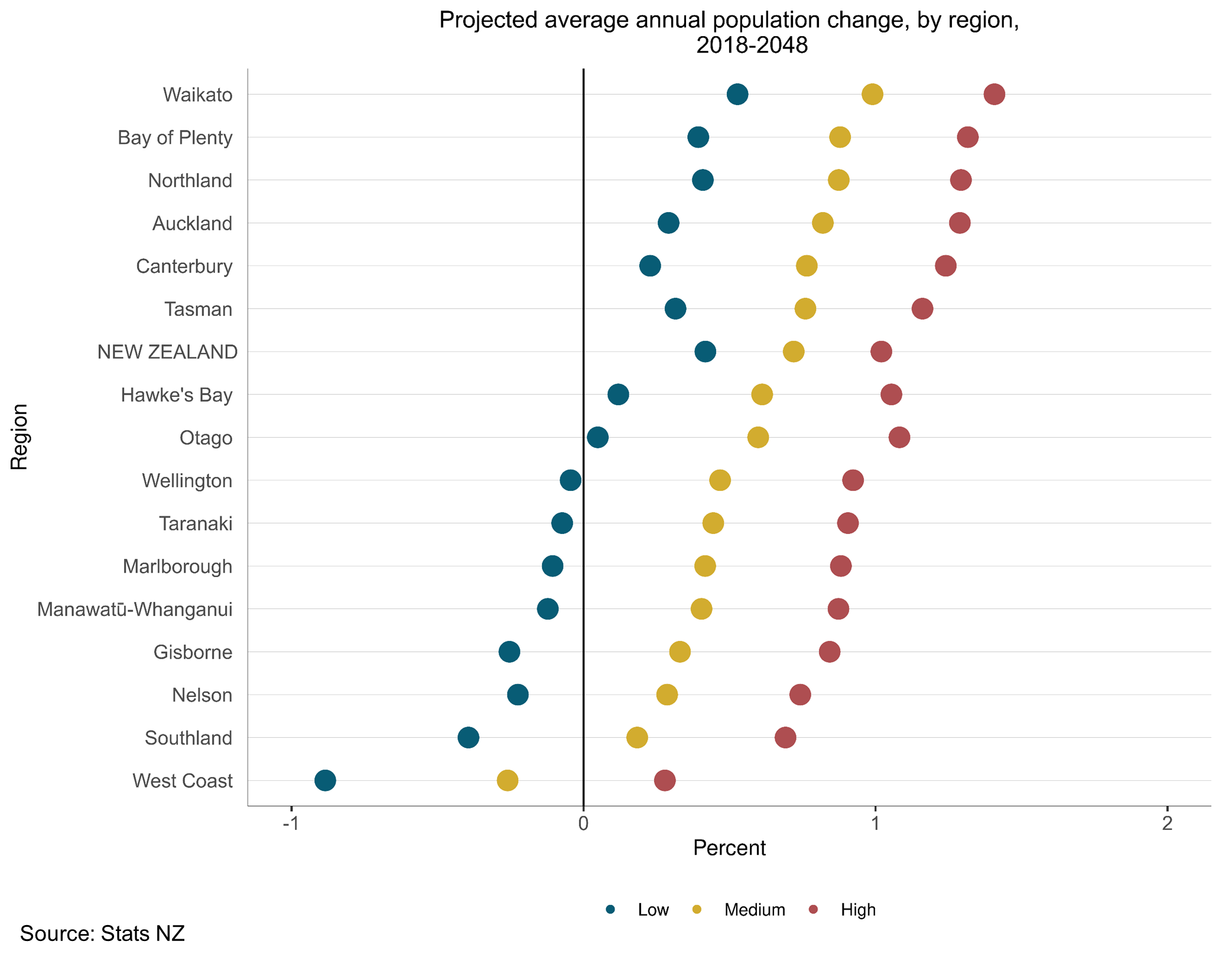The country's four northernmost regions are projected to contribute two-thirds of New Zealand's projected growth between 2018 and 2048, Stats NZ said today.
Northland, Auckland, Waikato, and Bay of Plenty will account for two-thirds of New Zealand's projected population growth, based on the medium growth projection . Currently, 54 percent of New Zealand's population live in these regions. See Subnational population estimates: At 30 June 2022 (provisional) for more information.
"Auckland, with the largest population, is projected to account for about 40 percent of New Zealand's overall growth between 2018 and 2048," estimates and projections manager Michael MacAskill said.
"However, Waikato is expected to grow the fastest of all 16 regions."
Waikato region's population is projected to grow an average of 1.0 percent each year. Other regions with annual growth rates higher than New Zealand's overall growth rate (0.7 percent) include Bay of Plenty and Northland regions (both 0.9 percent) and Auckland, Canterbury, and Tasman regions (all 0.8 percent).
The West Coast is the only region that may have a lower population in 2048 than in 2018 (based on the medium projection). The West Coast's population (32,700 in 2022) is projected to start declining in the early 2030s, decreasing to 30,000 by 2048. The decreasing population is due to more deaths than births, which may more than offset gains from net migration.
The North Island will contribute 80 percent of New Zealand's total growth over the projection period. The South Island will account for the remaining 20 percent, with Canterbury projected to make up the majority of this (14 percent of New Zealand's growth).

Text alternative for Projected average population change, by region, 2018-2048
Highest growth in people aged 65 years and over (65+)
Of the four broad age groups, growth will be highest in the 65+ population for New Zealand, and across all regions. The number of people aged 65+ living in New Zealand is likely to hit 1 million by 2028 (19 percent of the total population) and reach about 1.4 million by the late 2040s (23 percent). This is an average net increase of about 60 people moving into the 65+ age group each day between 2018 and 2048. One million people aged 65+ by 2028 has more information on New Zealand's projected ageing population.
Auckland will have the fastest-growing 65+ population, increasing from 197,000 in 2018 (12 percent of Auckland's population) to 426,100 by 2048 (20 percent of Auckland's population, based on the medium projection). With an average annual increase of 2.6 percent each year, this equates to a net increase of about 21 people moving into the 65+ age group each day between 2018 and 2048.
"Along with Auckland, growth of people aged 65+ is projected to be higher than the overall New Zealand growth rate for Tasman, Waikato, and Northland regions," MacAskill said.
Fewer children in 12 out of 16 regions by 2048
The number of children (0-14 years) is projected to drop slightly in 12 of New Zealand's 16 regions between 2018 and 2048. The areas that will have slight increases in the number of children include Waikato (increasing by 0.3 percent each year), Northland, Canterbury, and Bay of Plenty regions (all increasing by 0.1 percent).
"Waikato region, with the largest increase in children, will grow by just under one child per day, compared with nearly seven people moving into the 65+ group per day between 2018 and 2048," MacAskill said.
Fewer children in the population across regions reflects static or declining birth rates, combined with fewer people in the childbearing ages (15-49 years).
About these projections
These projections are not predictions. The projections should be used as an indication of the overall trend, rather than as exact forecasts. Stats NZ produces low, medium, and high growth projections for every local area every 2-3 years to assist planning by communities, local councils, and government. Projections used here are from the medium projection.
Projections are based on assumptions about future migration, birth rates, and death rates for each area. For New Zealand overall, the mid-range projection assumes:
- a net migration gain of 25,000 people a year from the June 2026 year onwards
- a period total fertility rate (TFR) of 1.70 births per woman in 2023, gradually decreasing to 1.65 from 2042-2048
- life expectancy will continue to increase, although this increase will slow.These projections assume current policy settings, and do not try to anticipate future major policy changes that may affect population change.
These projections assume current policy settings, and do not try to anticipate future major policy changes that may affect population change.
Text alternative for Projected average population change, by region, 2018-2048
The graph shows the low, medium, and high projected average annual population change 2018-2048 for each regional council area. The data for each projection are in different colours - low (blue), medium (gold), and high (red). The vertical line in the graph indicates zero percent of growth. The average annual population change ranges from 1.4 percent growth in Waikato using the high projection, to 0.9 percent decline in West Coast region using the low projection.






